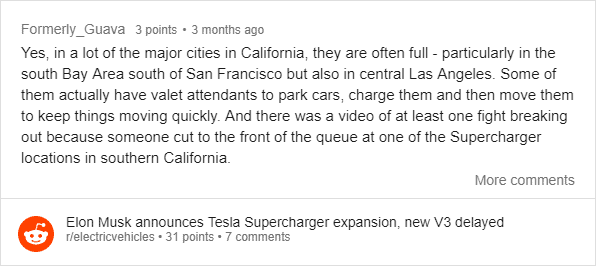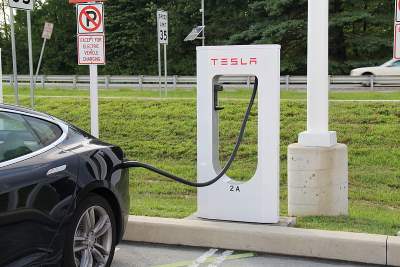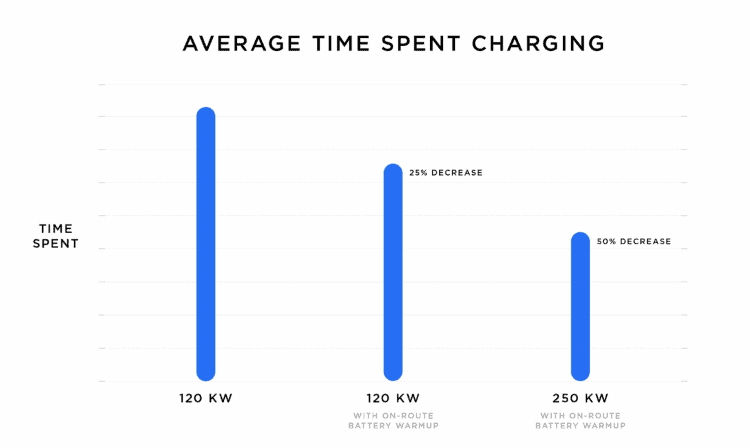In addition to their innovative cars, a big advantage with Tesla is access to their electric car supercharger network. Right now, Tesla have 1,441 supercharger stations around the World – with 12,888 actual superchargers. Their fairly exclusive charging network allows Tesla owners to easily charge up their car, instead of battling with all other EV owners to charge up in a general purpose charging station.
In both good and bad news, however, the Model 3’s production and sales rates have increased massively in the second half of 2018, and continuing into 2019. These increases in recent months (23,582 sales in September 2018 alone) has meant that the supercharger network is frequently overloaded in some areas:

This article explores the current supercharger network, and any future planned updates to it.
An Overview of the Supercharger Network

The supercharger network is made up of 12,888 superchargers (up from 11,414 superchargers in November 2018), which will apparently rise to 23,000 by the end of 2019 (if previous Elon Musk claims/promises can be believed).
The vast majority of the supercharger network is made up of ‘V2’ superchargers, whereby each supercharger has a 480-volt DC supply, and they supply electric power to a Tesla at a rate of 120 kW (via DC, into the 400-volt battery pack).
It can do this because each supercharger can charge two cars, so it distributes their 135 kWh supply to both, ‘juggling’ the power accordingly to distribute the power up to a maximum of 120 kW per car. Charging times can be 40 minutes from a ‘flat’ battery to 80% (the usual recommended amount) on a Model S, or 75 minutes to get a full 100% battery.
However 120 kW charging speeds started to becoming outdated (with Porsche building out a 350 kW network for their Taycan EV), leading to rumours about a ‘V3’ supercharger upgrade. Back in 2016, Elon Musk hinted at the V3 network having over 350 kW charging rates:
This would potentially have been enough to charge a Model S fully in 25 minutes or less. However after that tweet, there were some subsequent rumours that the heat within battery packs would be a bottleneck at such high charging speeds, and in a conference call on May 2nd 2018 appeared to say that the third gen charger would run at 200 kW instead.
A Tesla blog post on March 6th 2019 confirmed the charge rate will actually be at 250 kW for a Model 3, powered by a 1 megawatt power cabinet at each supercharging site. This would allow a Model 3 car to recover up to 75 miles (121 km) of charge in about 5 minutes. Another update from Tesla’s blog on April 23rd 2019 unveiled an improved Model S and X drivetrain (for models produced in 2019 onwards), such that V3 superchargers will deliver 200 kW charge rates – along with a boost of 145 kW for V2 superchargers.
Tesla also announced that their cars will start automatically “warming up” their batteries when they are on-route to a Tesla supercharger station. This would increase the efficiency of the charging process, reducing charge times by up to 25%. This all means that a warmed up Tesla car will spend 50% less time in a supercharger station than they would have with a V2 charger:

Prices (and Exemptions) of the Network
Tesla’s supercharger network had been free for the first 5 years of its roll-out, with the Model X and Model S cars have unlimited access to it. They (and some Model 3s) continue to have unlimited access to the network, however any newly purchased Tesla cars (of any model) from mid September 2018 will no longer get the free charging.
Tesla also pre-empted this change by increasing the price of electric at their superchargers, back in March 2018. Increases ranged from $0.12/kWh to $0.24/kWh (in Oregon) to $0.20/kWh to $0.26/kWh in California – increases of 30-100%! At this point, prices were still cheaper than gasoline prices, however, and Tesla confirmed at the time that this wasn’t a profit-seeking change:
“We occasionally adjust rates to reflect current local electricity and usage. The overriding principle is that Supercharging will always remain significantly cheaper than gasoline, as we only aim to recover a portion of our costs while setting up a fair system for everyone. This will never be a profit center for Tesla”
However Tesla increased the price quite a lot in January 2019, with an average price increase of 33%. New Yorkers and Californians will now be paying $0.32-$0.36/kWh, quite a large increase compared to the $0.20/kWh before the March 2018 price rises!
These January 2019 price hikes mean that the electric from the supercharger network is now starting to reach parity with gasoline prices. A Model 3 (Tesla’s most efficient electric car) has a comparable supercharger electric price to that of a 35 MPG gasoline car (assuming $0.34/kWh electric and $3.00 per gallon of gasoline), whilst the more powerful (hence less efficient) Model S would be similar to a 25 MPG gas car.
This also affected other countries, such as the United Kingdom where the price of electric risen from £0.20/kWh at the end of 2018 to £0.27/kWh in January 2019 – a 35% price rise.
In the United States, the prices to fully charge a Tesla are now:
- Tesla Model X: $172 per 1,500 miles (similar price to a 25 MPG gas car)
- Tesla Model S: $151 per 1,500 miles
- Tesla Model 3: $129 per 1,500 miles (similar price to a 35 MPG gas car)
Please note that the above figures are taken from Tesla’s supercharger page but adjusted slightly because they list electric at $0.31/kWh and they are comparing to 21 MPG gas cars (which feels like an unfair comparison – their electric is now more than $0.31/kWh in their key markets, and the majority of modern American gasoline cars have more than 21 MPG).
In the United Kingdom, the figures are:
- Tesla Model X: £137 per 1,500 miles (at £0.27/kWh); compared to £264 with gasoline (48.1% cheaper)
- Tesla Model S: £121 per 1,500 miles; compared to £238 with gasoline (49.2% cheaper)
- Tesla Model 3: not yet released
So whilst the United Kingdom and some other European countries do still enjoy cheaper fuelling costs for a Tesla (compared to gasoline cars), the United States (Tesla’s biggest market) is starting to level out: the Model 3 probably still beats out the 27 MPG of the Audi A4, although the A4 hits 34 MPG on highways meaning that the Model 3 has no running cost advantage (anymore) for long trips.
Tesla Supercharger V3 Network – Technical Details
For fans of technical details, Reddit user Netbrown has posted the following technical statistics and details about the new supercharger V3 upgrade:
- The charging cables are liquid-cooled, but will be thinner than V1 and V2 supercharger cables. This is because the coolant pump will be located in the base of the white supercharging unit which the cable connects to (allowing for charging there, instead of along the whole cable).
- V3 superchargers will have 40% better throughput performance per site, compared to V2.
- V3 cabinets will house two DC-to-DC modules per post, yielding 100 kW each for a total of 200 kW power delivery. They will also have five power stages at 70 kW per power stage, meaning 350 kW AC to DC per cabinet.
- The main controller on each supercharger site will use 4G LTE communication with central Tesla supercharging management hubs, for all diagnostic and usage data. This means that faults (and bottlenecks) can be detected almost in real time, instead of someone having to go to each site and read data from memory chips periodically.
- V3 will have 96% power conversion efficiency compared to 92% with V2, along with no overvoltage sensitivity and less harmonics, leading to 20% more customers served for each dollar of power.
- The overall AC input is 438kVA (526 A), linking to seven V3 cabinets per bus/block – or a single Tesla Power Pack. The V3 supercharger cabinets are configured on a DC radial bus/block at 880-100 volts, where the power is pushed out to the individual chargers at DC 180-500 volts for 250 kW max wattage.
- Based on the above, a five cabinet site (powering 20 individual superchargers) will need 2 MVA, with 4x 700 MCM AC feeders per cabinet.
- 0 or 1 gauge copper ground cabling will serve each cabinet, whilst the DC output lines to the individual chargers will use 4x 300 MCM copper and 2 AWG copper ground cabling.
20th November 2018 Update
As a result of the availability issues mentioned at the start of this article, Elon Musk Tweeted overnight on 19th/20th November 2018 saying:
If this is accurate (and we say if because this isn’t the first time that Tesla have talked about almost doubling supercharger levels), this would take the supercharger levels to around 23,000 by the end of 2019. If this is done, and also Teslas can charge much quicker with the V3 charger, this should help to alleviate the issues Tesla owners have been facing when charging at peak times.
This will also be important from a competition point of view, because the Porsche Taycan (being released Q3/Q4 2019) will have a 350 kW charge rate.
20th January 2019 Update
Unfortunate news came in on Saturday 20th January which was that Tesla have again raised their supercharger electric prices, by an average of 33% in most areas.
New Yorkers will now be paying $0.32/kWh (up from $0.24/kWh), whilst California residents will be paying $0.32-$0.36/kWh, up from $0.26/kWh. These price rises mean that Tesla’s supercharger electric prices are now comparable with gasoline cars: a Model 3 will see prices comparable to a 35 MPG gasoline car, whilst the Model S’s comparable MPG (which uses 35-40% more electric than the Model 3) would be around 25 MPG.
Prices were $0.20/kWh in California at the start of March 2018, and they now average $0.34/kWh – a 70% increase in just nine months. Tesla have confirmed that this change is not to turn the network into a profit making enterprise, but is purely to keep funding new superchargers.
In reality, it is probably the case that Tesla were still subsidizing electric prices on their network even after the March 2018 price rises, and this change probably brings an end to this internal subsidizing.
6th March 2019 Update
As we mention above, a Tesla blog post has unveiled V3 supercharging which offers 250 kW charging (double the previous speeds), which should result in Tesla owners spending 50% less time in their superchargers. Tesla also rolled out a software updated called On-Route Battery Warmup which (as the name would suggest) starts warming up the battery when a Tesla car is heading to a supercharger. This will allow the car to charge up more efficiently, because charging a cold battery can take significantly longer.
